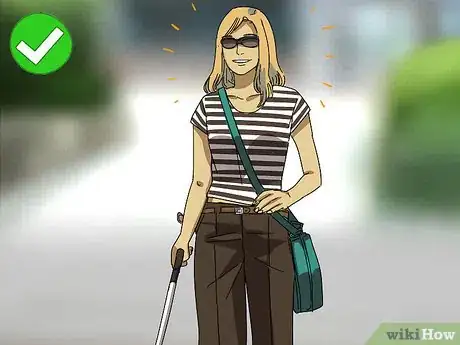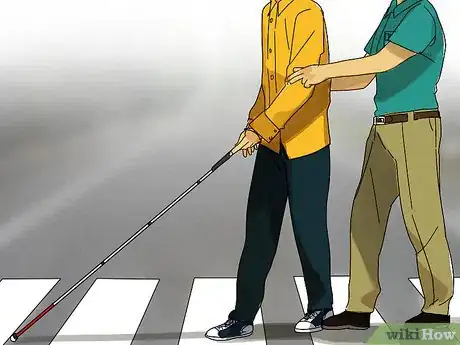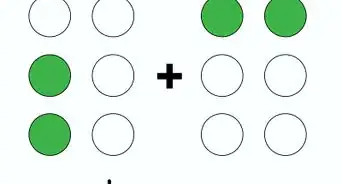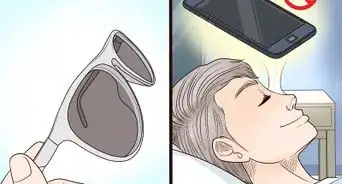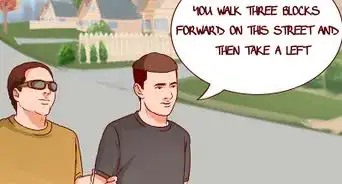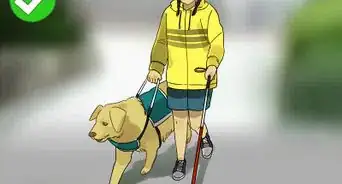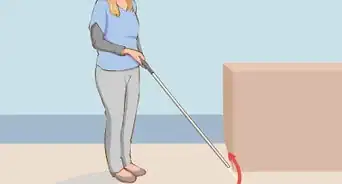wikiHow is a “wiki,” similar to Wikipedia, which means that many of our articles are co-written by multiple authors. To create this article, 52 people, some anonymous, worked to edit and improve it over time.
There are 7 references cited in this article, which can be found at the bottom of the page.
wikiHow marks an article as reader-approved once it receives enough positive feedback. In this case, 91% of readers who voted found the article helpful, earning it our reader-approved status.
This article has been viewed 175,022 times.
Learn more...
Interacting with someone who is blind may be a little daunting at first. But with an open mind and this article, you will realize that they are just like you and everyone else!
Steps
-
1Treat them as just another person as they simply do things differently.[1]
- Many people assume that people who are blind have other medical conditions. This may be so but is not always the case. Unless you know for sure assume blindness is the only medical problem this person has.
- Being blind does not mean that they cannot do anything, nor does it mean that they have lower-than-average common sense. It is only a physical challenge.
-
2Bear in mind that people who are blind who use guide dogs and/or white canes treat them as extensions of their bodies. Never distract guide dogs from their job or touch, move, or grab a cane without the owner's permission.[2]
- Imagine if someone moved your keys once you've established a location in which you can readily and quickly retrieve them. That'd slow you down. Plus, it's personal property. The keys allow the sighted person to drive a car which is a mobility tool and the white cane allows the blind individual to travel effectively, independently and safely which also acts as a mobility tool.
- Guide dogs that may be present are not super animals, they can be distracted by cooing, talking, whistling, food, and other animals. Distracting a guide dog can cause a someone who is blind to lose their life. It is the dog's responsibility to ensure the next step they take is safe. They cannot do this if they are looking at you.
Advertisement -
3Identify yourself and others who may be with you when meeting someone who is blind. Ideally, instead of saying "This is John," (or whoever) have those who are with you introduce themselves, one at a time, to them. When conversing in a group, remember to identify the person to whom you are speaking to if there may be doubt as to who the comment is directed to, i.e. using their name — otherwise, they will become confused as to whether or not you are speaking to them. However, overusing names during a conversation can be annoying to everyone involved, not only the person who is blind. Generally, do not modify the way you speak. Most people who are blind can tell who you are talking to by the direction you are facing or the acoustics of the room. In most cases, if there is confusion, the person who is blind will ask for clarification.[3]
- Always inform the person who is blind verbally that you are leaving before your leaving from the place so that they will not be left talking to the air.
- Never talk only to a third party who might be with them, such as their spouse, driver, reader, teacher, tutor etc. Look at them and speak as you would to anyone else.
- Don't talk to guide dogs, this is insulting and the dog never answers.
- Do not shout; just speak in a normal tone of voice as usual.
-
4Remember that not everyone who is considered 'blind' are 100% blind. Some people who are legally blind have limited vision, others can see some in different light levels such as dusk or cloudy light, and yet others may have pinhole vision or peripheral vision.[4]
- Never touch or grab someone in efforts to assist.
- Never place an item in their pockets or grab an item of theirs in efforts to assist.
- They may not be able to see, but most are still physically able.
-
5Wait until the offer is accepted if you offer assistance. Then listen or ask for instructions. Many blind people will accept help; however, make sure that they are aware that you are going to help them and offer your arm, not your whole body.[5]
- Do not clap, repeat or push when attempting to guide someone who is blind. This would be somewhat rude, imagine how you would feel if someone was guiding you with clapping and repeated directions. Be consistent and specific when you are describing things and giving directions. The more accuracy, the more consistency, the more direct and the more description you use, the more effective your interaction will be.
- Do not assume that they cannot do stuff for themselves. Many are able to serve themselves, find things, pick up things, and carry things etc. If in doubt simply ask if they would like assistance, and do not be insulted if they say 'No, thank you'.
-
6Relax. Don't be embarrassed if you use common expressions such as “See you later” or “Did you watch the movie this weekend?”. Just as a person who uses a wheelchair still goes for a walk, a blind person will still be pleased — or not — to see you. In other words, blind people use the same expressions as those who are sighted.[6]
-
7Be careful with terminology. Some words, such as 'handicapped' are seen as not politically correct. Not all people who are blind feel this way, but some do, try to gauge their reactions and apologize if they seem upset by a word. Acceptable descriptive words would be 'blind' 'visually impaired' and 'low vision' (if the person has some vision).
Warnings
- If you do not comply with the above guidelines, you could face legal or social repercussions, possibly concerning but not limited to:
- Assault
- Discrimination
- Privacy
- Property
⧼thumbs_response⧽
References
- ↑ https://www.letsenvision.com/blog/how-to-interact-with-the-blind
- ↑ https://msb.dese.mo.gov/resources/interacting-with-visually-impaired.html
- ↑ https://www.visionaustralia.org/information/family-friends-carers/communicating-effectively
- ↑ https://www.lifehack.org/articles/communication/13-things-may-know-blind-people.html
- ↑ https://www.dhs.wisconsin.gov/blind/adjustment/dos-donts.htm
- ↑ https://chicagolighthouse.org/sandys-view/interactions/
- How Do I Talk to a Blind Person? | Center for the Blind


-Step-7-Version-2.webp)
